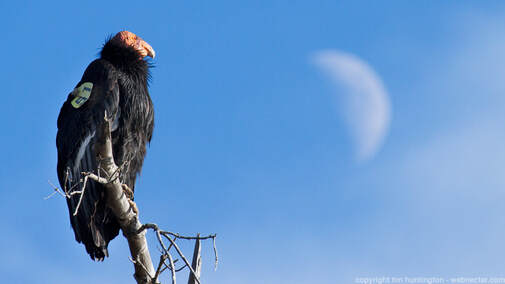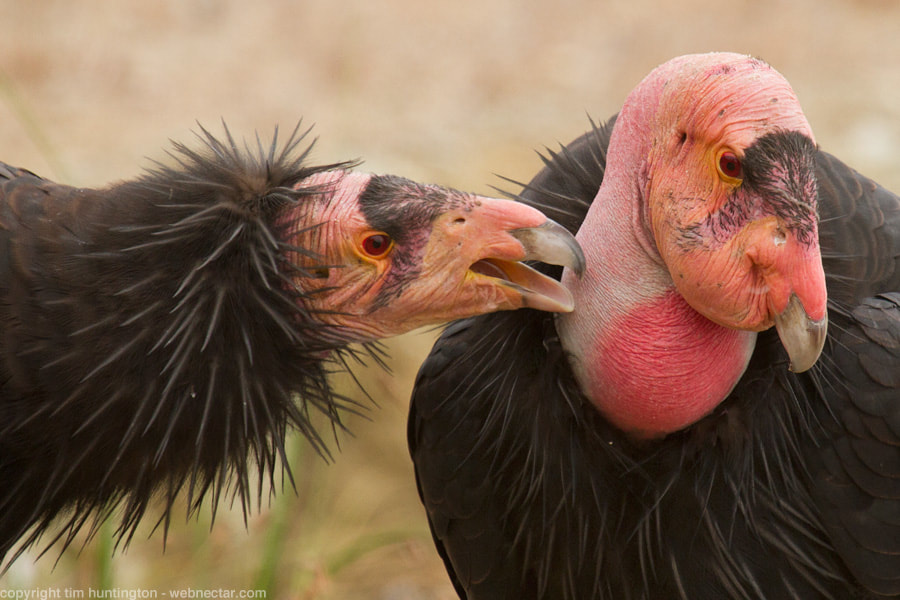Loading bio data
Condor (251), aka "Crush", died of lead poisoning near our release site on July 10, 2016. While his death is very unfortunate, we prefer to celebrate his incredible life and the great legacy he left behind. His contributions to the wild flock spanned 15 years, and are difficult to quantify in words, but were instrumental to the ongoing recovery of condors in Central California.
When Crush (251) and four other pre-release condors arrived at our Big Sur release pen in the Summer of 2002, they were bright-eyed and very curious. Crush (251) quickly climbed to the top of the hierarchy among the pre-release group, a pattern that would continue in to his adult years. After release on December 12, 2002, Crush (251) took his first (and clumsiest!) flight, dropping down a couple thousand feet in elevation deep into a redwood grove at the base of the canyon - a difficult start for any newly released condor. We've seen this happen with other recently released birds and they eventually work their way back to the release site over the course of a week or two, but this wasn't the case for Crush (251).
By the end of December, he was still down low in the canyon and we hadn't documented him feeding since his release, 19 days prior. This pattern continued in to early January and things were looking quite bleak - we were seriously worried for his welfare. But just when we thought it couldn't get any worse, we noticed a new pattern developing. Everyday around noon we noted that two adult condors, Patriarch (164) and Traveler (171), were radio-signaled in the same exact location as Crush (251) for about an hour. This pattern continued daily up until his long-awaited return to the release site on 1/23/2003.
While we expected Crush (251) to look famished upon his return to the feeding slope, we were pleasantly surprised to see he was in great physical health. This was our first indication that condors could be altruistic and feed a condor that wasn't their own offspring. Without Crush (251)'s shaky start we may have never known that altruism was such an important condor trait.
Crush (251) quickly climbed the condor hierarchy and when he reached breeding age in 2010 he was poised to nest. He just needed to find a mate which is easier said than done in the world of condors. However, in 2011, a window of opportunity presented itself to Crush (251). Condor female, Cosmo (222), lost her male mate (who was injured and recovering in captivity) and Crush (251) promptly swooped in and paired up with her. He retained this nesting territory over the next 5 years and even took in a second female, Condor (306), from 2012-2015. The trio cooperatively nested in the same territory, alternating nest sites each year, which basically gave Crush (251) no time to rest (what a super dedicated condor dad!). Crush (251) will be remembered for fathering/fostering four nestlings in his lifetime, which remains a truly invaluable and lasting contribution to the recovery of his species. Thank you Crush (251), your legacy will be a lasting one.
When Crush (251) and four other pre-release condors arrived at our Big Sur release pen in the Summer of 2002, they were bright-eyed and very curious. Crush (251) quickly climbed to the top of the hierarchy among the pre-release group, a pattern that would continue in to his adult years. After release on December 12, 2002, Crush (251) took his first (and clumsiest!) flight, dropping down a couple thousand feet in elevation deep into a redwood grove at the base of the canyon - a difficult start for any newly released condor. We've seen this happen with other recently released birds and they eventually work their way back to the release site over the course of a week or two, but this wasn't the case for Crush (251).
By the end of December, he was still down low in the canyon and we hadn't documented him feeding since his release, 19 days prior. This pattern continued in to early January and things were looking quite bleak - we were seriously worried for his welfare. But just when we thought it couldn't get any worse, we noticed a new pattern developing. Everyday around noon we noted that two adult condors, Patriarch (164) and Traveler (171), were radio-signaled in the same exact location as Crush (251) for about an hour. This pattern continued daily up until his long-awaited return to the release site on 1/23/2003.
While we expected Crush (251) to look famished upon his return to the feeding slope, we were pleasantly surprised to see he was in great physical health. This was our first indication that condors could be altruistic and feed a condor that wasn't their own offspring. Without Crush (251)'s shaky start we may have never known that altruism was such an important condor trait.
Crush (251) quickly climbed the condor hierarchy and when he reached breeding age in 2010 he was poised to nest. He just needed to find a mate which is easier said than done in the world of condors. However, in 2011, a window of opportunity presented itself to Crush (251). Condor female, Cosmo (222), lost her male mate (who was injured and recovering in captivity) and Crush (251) promptly swooped in and paired up with her. He retained this nesting territory over the next 5 years and even took in a second female, Condor (306), from 2012-2015. The trio cooperatively nested in the same territory, alternating nest sites each year, which basically gave Crush (251) no time to rest (what a super dedicated condor dad!). Crush (251) will be remembered for fathering/fostering four nestlings in his lifetime, which remains a truly invaluable and lasting contribution to the recovery of his species. Thank you Crush (251), your legacy will be a lasting one.







